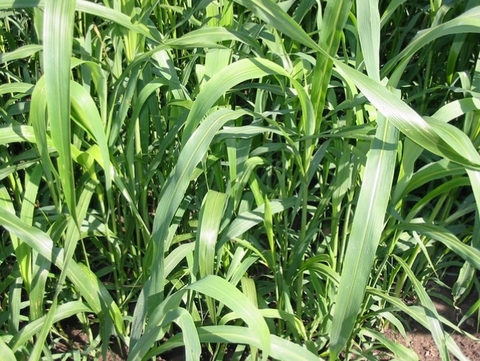To become more profitable, some dairy producers need forages to fill slumps in grazing systems, extend the grazing season and provide emergency cover and forage. In addition, dairy producers are looking for ways to integrate cover crops in their cropping and pasture systems.
To better understand the potential of forage and the nutritional value of cover crops, University of Minnesota researchers evaluated cover crop species to help establish cultural practices and nutritional value for specific crops.
Cover crops evaluated
The following cover crops were evaluated: Annual ryegrass, berseem clover, buckwheat, BMR sorghum-sudangrass, crimson clover, fodder beets, forage oats, forage peas, grazing corn, kale, lentils, pearl millet, Phacelia, Rox Orange cane, sorghum-sudangrass, soybeans, sugarbeet, Sunn hemp, teff and turnip.
Study methods
Researchers planted replicated plots of cover crops at the West Central Research and Outreach Center in Lamberton and on a dairy farm in Lanesboro. Details:
Plots were planted on June 24 and harvested on Aug. 20.
A plot flail harvester was used to harvest the cover crops and dry matter yields were determined.
A sample of harvested forage was retained from selected plots for dry matter determination and forge quality analysis.
Dairyland Laboratories in St. Cloud conducted the forage analysis.
Results
Forage analysis differed among species with crude protein ranging from a high of 24.0 percent for fodder beet tops to a low of 10.9 percent for BMR sorghum-sudangrass (Table 1).
Total digestible nutrients (TDN) was highest for sugarbeets and turnip tops with 68.6 and 67.8 percent, respectively. However, TDN was the lowest for forage peas and grazing corn (45.5 and 48.4 percent, respectively).
Taller plants, such as BMR sorghum-sudangrass and Rox Orange yielded greater amounts of dry matter per acre. The lush turnip and kale tops excelled in forage quality but were lower in dry matter yield per acre.
From these data, we can better recommend species combinations to fit certain cover crop and grazing scenarios.
Cover crop yield and forage quality (2015)
| Cover crop | Dry matter yield: Kilograms | Dry matter yield: Tons | Crude protein | NDFd* | Lignin | TDN* |
|---|---|---|---|---|---|---|
| Annual ryegrass | 2,183 kilograms per acre | 2.4 tons per acre | 21.70% | 37.90% | 5.40% | 60.60% |
| Berseem clover | 1,013 kilograms per acre | 1.1 tons per acre | 22.40% | 38.50% | 6.60% | 60.90% |
| Buckwheat | 1,507 kilograms per acre | 1.7 tons per acre | 13.60% | 42.40% | 7.30% | 58.00% |
| BMR sorghum-sudan | 4,045 kilograms per acre | 4.5 tons per acre | 14.30% | 53.70% | 2.80% | 62.20% |
| Crimson clover | 1,371 kilograms per acre | 1.5 tons per acre | 20.40% | 38.10% | 3.90% | 63.60% |
| Fodder beets | 1,266 kilograms per acre | 1.4 tons per acre | 24.00% | 33.40% | 3.70% | 66.70% |
| Forage oats | 1,436 kilograms per acre | 1.6 tons per acre | 16.60% | 51.00% | 3.70% | 62.20% |
| Forage peas | 2,909 kilograms per acre | 3.2 tons per acre | 13.50% | 41.10% | 7.20% | 45.50% |
| Grazing corn | 5,797 kilograms per acre | 6.4 tons per acre | 13.40% | 32.70% | 3.30% | 48.40% |
| Kale | 1,239 kilograms per acre | 1.4 tons per acre | 23.20% | 39.00% | 4.50% | 65.20% |
| Lentils | 566 kilograms per acre | 0.6 tons per acre | 14.80% | 49.80% | 4.80% | 52.20% |
| Pearl millet | 3,066 kilograms per acre | 3.4 tons per acre | 15.90% | 54.80% | 2.60% | 60.60% |
| Phacelia | 404 kilograms per acre | 0.4 tons per acre | 21.40% | 34.20% | 4.20% | 63.70% |
| Rox Orange cane | 9,130 kilograms per acre | 10 tons per acre | 12.70% | 51.30% | 3.00% | 63.20% |
| Sorghum-sudangrass | 6,580 kilograms per acre | 7.2 tons per acre | 10.90% | 56.10% | 3.30% | 58.40% |
| Soybean | 612 kilograms per acre | 0.7 tons per acre | 22.10% | 37.90% | 4.40% | 62.60% |
| Sugarbeet | 2,845 kilograms per acre | 3.1 tons per acre | 21.70% | 29.30% | 3.30% | 68.60% |
| Sunn hemp | 1,790 kilograms per acre | 2.0 tons per acre | 19.80% | 37.60% | 4.90% | 62.60% |
| Teff | 3,059 kilograms per acre | 3.4 tons per acre | 17.70% | 59.00% | 4.00% | 60.20% |
| Turnip | 1,600 kilograms per acre | 1.8 tons per acre | 17.20% | 28.60% | 2.40% | 67.80% |
| NDFd=Neutral detergent fiber digestibility; TDN=Total digestible nutrients. |
Reviewed in 2018


